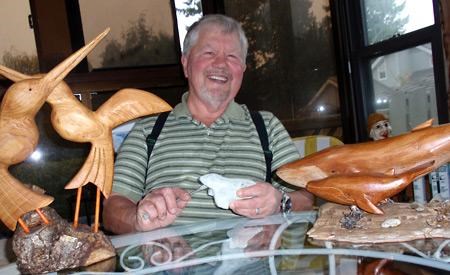Life has been a fantastic adventure for Bill Kristofferson, 74, of Texada Island. Born in Sweden and named for a comic book hero, Kristofferson lived with Bedouins in the Middle East, dived with underwater guru Jacques Cousteau, discovered an unknown 2,200-year-old Roman city in Libya, befriended renowned carver Bill Reid and was adopted into the Haida nation. He was also the first person to circumnavigate the Mediterranean by sail in an Arab dhow without a crew or engine. He sailed to the south Pacific, in a 43-foot trimaran he designed and built himself, and is as much at home on boats as he is in houses.
Any one of these achievements could be considered the pinnacle of one’s life, but Kristofferson has done them all.
Born in the Swedish seaport of Sundsvall, he was named after comic book hero Bill of the Northwest Mounted Police, and as a young child learned sailing and carving from his grandfather. When he was nine, the family moved to BC, where his father, a blaster-miner, was hired to help build tunnels through the Rocky Mountains for construction of the Trans Canada Highway. Three years later, they moved to Texada where his dad continued mining work. When other teens were doing homework, Kristofferson built dinghies for summer residents of Gillies Bay who commuted to the island by boat. He built kayaks and paddled across the Strait of Georgia many times. He began skin-diving, using long johns painted with deck paint as an underwater suit.
He was one of six members of Texada Island Secondary School’s first graduating class and after touring Europe by motorcycle attended the University of Stockholm, where tuition was free, graduating as a structural engineer and naval architect.
Kristofferson was hired to build a factory in Tunisia, then schools in Libya. He sailed an Arab dhow around the Mediterranean, from which he discovered the ancient Roman city of Sabratha along the Libyan shore. After spending time with Bedouins he moved to Monte Carlo where he trained as a commercial diver with a friend’s father, Jacques Cousteau. After sailing across the Pacific to the South Seas, he returned to BC for building projects on Vancouver Island and the Sunshine Coast and took his family to the Queen Charlotte Islands (Haida Gwaii) for a holiday. He was quickly offered a job and stayed eight years.
While there, the Haida band council in Skidegate decided to build the first traditional longhouse in 100 years and hired Kristofferson and renowned carver Bill Reid to plan and construct the six-beam structure based on indigenous designs. “Reid was the most humble, generous, amazing person I ever met,” Kristofferson said. Both he and Reid were formally adopted by the Haida nation after completion of the project, which Kristofferson said was a great honour.
For Expo ‘86 in Vancouver, Kristofferson was hired to build seven pavilions, including the massive longhouse-style Folklife Pavilion. He was then hired to create similar pavilions for Expo ‘88 in Brisbane, Australia and Expo ‘92 in Seville, Spain.
Back on the coast of BC, Kristofferson and his wife Sherodann were sailing up the Strait of Georgia in 1994 en route to a holiday in Desolation Sound, when he asked her if she wanted to see where he lived as a child and she agreed. They ended up buying a house in Gillies Bay and never made it to Desolation Sound. They moved to Van Anda in 2005 and Kristofferson continued to work in the construction industry until 2010.
“The most important thing I’ve learned is to have the confidence in yourself to try new things,” he said. “I’ve always sought out challenges and the rewards have been worth it. I’ve met lots of exceptional people in many countries and I’ve gained something from everyone I’ve met.”
He doesn’t consider himself retired, continuing to carve and to design and build boats. “Boats are just sculptures in a larger medium,” he said. Kristofferson built dozens of boats to date and continues to sail in his 34-foot catamaran docked in Van Anda. From kayaks to ocean cruisers, Kristofferson said his goal is to design “safe, comfortable, simple-to-construct, high-performance vessels.” He sells his designs through his company, Kismet Multihull Dezines.
His carvings are mainly of marine life in yellow and red cedar. “With any boat design or carving, you come up with an image in your mind and attempt to bring it to life as a full-sized boat or carving.”
Kristofferson has no plans to fully retire, “because retirement means you’ve stopped. I’ve never stopped, but rather my life has just changed phases.”



